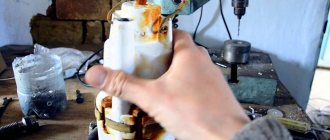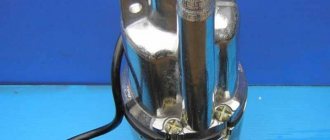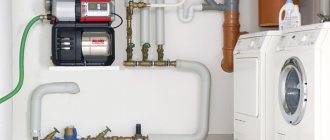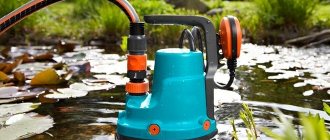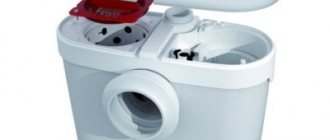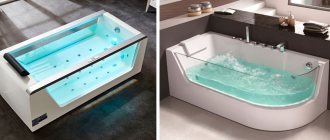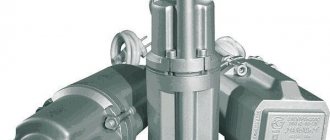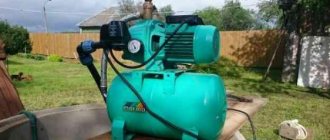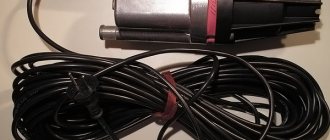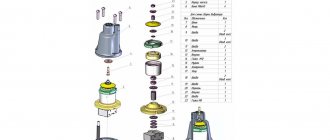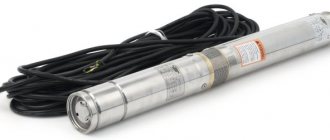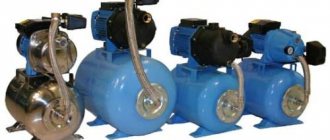The electric vibration pump “Malysh” is intended for domestic use, namely for lifting water from wells, boreholes and open reservoirs.
It is also suitable for drainage. The design of the submersible pump does not require complicated installation.
To start work, it is necessary to install the unit in a well with a minimum diameter of 100 mm (for the Malysh-3 modification - min Ø 80 mm). Then fix the pump at the required depth, taking into account the maximum immersion depth of 3 m.
After being connected to a 220 V home power supply, the pump is ready for use. The water pressure depends on the supply height (maximum height - 40 m). On average, when delivering to a height of 20 m, the pump productivity reaches 0.43 m3/h (when operating without pressure - up to 1.5-1.8 m3/h, depending on the model).
- 2 Scope of application
- 3 Which water intake should you prefer?
- 4 Features of use
Key features and areas of application of Malysh pumps
The advantages of “Malysh” type pumps are:
- small diameter, which does not exceed 255 m;
- lightness, bordering on the level of 3400 g;
- adaptability to relatively warm t 0C water (no more than =35);
- the ability to transport water to a consumer located at a distance of no more than 100 m from the point of water intake (open reservoir);
- uninterrupted operation with liquids containing about 0.01% suspended particles. They are not intended for dirty water;
- low power - about 250 W;
- 200 V voltage requirement with slight deviations of 5%. Considering that this parameter in the network is quite dynamic, in order to avoid breakdowns, an additional voltage stabilizer is installed, which will smooth out differences and protect equipment from surges;
- average throughput is about 400 liters per hour.
Malysh pumps are used for:
- water intake and subsequent water supply of residential and industrial premises, farms;
- pumping liquid from artificial containers;
- drainage of flooded rooms, basements;
- filling swimming pools and other small hydraulic structures;
- organization of irrigation systems for land plots and greenhouses.
Application area
The compact vibration submersible pump “Malysh” is suitable for autonomous water supply at sites with low water consumption.
It is suitable for providing water supply to country houses and watering summer cottages.
“Malysh” is indispensable in rural areas, where it is capable of solving a number of pressing problems:
- establish a supply of drinking water to your home;
- provide water supply to household plots and garden plots (the pump can be easily integrated into automatic irrigation systems that provide irrigation and spraying of plantings);
- pump out water when flooding the ground floors of estates and basements.
Specialist's note: Malysh pumps are not suitable for pumping out heavily contaminated water.
Design of the “Malysh” pumps
A diagram of the internal structure of pumps of this brand is shown in the figure below.
The designations correspond to:
1 – core – power and waterproofing mechanism of the pump, built into the body with epoxy resins;
2 – coil;
3, 9 – body parts made of corrosion-resistant metal;
4 – electric motor armature;
5 – rod;
6 – shock absorber, which in some modifications has an additional metal circle;
7 – coupling separating the electrical circuit and the intake chamber in the housing;
8 – emphasis;
10 – check valve – maintains pressure in the pipes and prevents the pumped volume from flowing back;
11 – rubberized piston;
12 – diaphragm.
Pump operating principle
The baby (in fact, like any other vibration-type unit) operates on an inert principle - in other words, there is a special vibrator inside the pump that gives the water oscillatory movements. The vibrator itself is made in the form of an anchor with a rod attached to it. After turning on the equipment, the armature is attracted to the magnet, after which the latter is turned off, and it (the armature) returns together with the rod to its original position thanks to a special spring. The frequency of such oscillations is about 50 times per second.
From all of the above, we can conclude that the Malysh, having such a simple design, due to its characteristics, is still capable of maintaining a fairly high pressure in the system.
Operating principle of “Malysh” pumps
These units function as follows:
- at the moment of connection to the power source, the armature is attracted by an electromagnet;
- After the process of “reversing the polarity” of the magnet, the core changes location. In this case, oscillations arise, the frequency of which is up to 100 units/s;
- vibrations from the rod are transferred to the piston. At this moment, a pressure is created that directs the liquid phase forward/upward through the pipeline;
- In the event of a sudden power outage, a check valve is activated, which keeps the water column at the same level.
Purpose
The Livgidromash enterprise (Russia) produces small vibration pumps “Malysh”, which are designed to supply liquid from wells, reservoirs, and reservoirs.
The characteristics of the device and low cost make it popular among Russians and residents of neighboring countries. The popularity is due to the simplicity of the design, uncomplicated installation procedure, reliability and durability.
Pumps "Malysh" are able to:
- Raise water from a shallow Abyssinian well if the diameter of the casing pipe is 8-11 cm.
- Pump liquid from an open reservoir, which is located at a distance of up to 100 meters.
- Fill the reservoir, providing an area with sufficient water to irrigate crops.
- Provide residents of a private home or cottage with water for drinking, hygiene, cooking and other household purposes.
- Pump out liquid from basements in case of flooding, a swimming pool when unnecessary, a pit after a rainstorm, etc.
Water pumps “Malysh” pump silted liquid as efficiently as clean water. The limit on the content of solid inclusions is 0.01% of the total volume of the aqueous solution.
Model range of pumps “Malysh”
This series of pumps includes several varieties, which we will discuss in more detail.
Basic model of “Malysh” pumps
A submersible pump with a bottom water intake that effectively transfers liquid between remote points (at a distance of about 150 m). Popular among rural residents and summer residents, who use it for irrigation.
Peculiarities:
- lack of thermal protection for the engine, pre-filter and pressure regulator;
- residential grade performance;
- readiness for continuous work for 2 hours;
- connection to a household electrical outlet.
Specifications:
- Feed – up to 5 m;
- Head – 40 m;
- Productivity – 432 l/h;
- Required hose diameter (internal) – 2.2 cm;
- Weight – 3.5 kg.
Submersible pump "Malysh-M"
A variant of the classic design, but with an upper water intake valve. Ideal for wells, boreholes or surface sources whose bottom sediments have a silty structure. Considered more durable and wear-resistant than the previous bottom intake pump. This is due to the fact that clay or sand particles that get into the pump mechanism are the main reason for its failure. Its operational characteristics are completely identical to those discussed above.
Pump “Baby”-3
A deep pressure device, which is considered the optimal price-quality ratio. Ideal for shallow wells.
Advantages:
- complete sealing and waterproofing of the hull and engine part;
- Traction force acceptable for shallow wells;
- lightness of the structure, simplifying its installation;
- complete with waterproof cable;
- possibility of retrofitting with filtration elements, both factory-made and home-made.
Working properties:
- Power – 0.165 kW;
- Productivity – 0.432 m3/h;
- Rise – 20 m;
- Weight – 2.5 kg.
Installation and connection features
The main rule: the pump must be mounted in a vertical position, otherwise its service life will be seriously reduced. And the depth of its immersion should be such that the suction hole is always in the water. Therefore, you need to know the lower dynamic water level in your source.
Dynamic and static levels
For reference. The dynamic level is the mark at which the water in the well is kept when the pump is running. It depends on its performance.
Installation instructions:
- Prepare a water supply hose. Its length should correspond to the immersion depth, and its diameter should correspond to the diameter of the pressure pipe;
- Secure the hose to the pipe using a plastic clamp;
- Secure the filter to the suction pipe. This is especially true for pumps with bottom water intake, since mechanical impurities entering the working chamber of the device lead to rapid wear of the check valve and piston, clog the hose, which leads to a critical increase in pressure inside the device;
Advice. Pumps with bottom water intake should not be placed closer than 50 cm from the bottom of the well or well, even if they are equipped with a filter.
- Make sure the network cable is long enough. If this is not the case, you need to build it up with your own hands, but so that the connection point is above the level of the well;
- Use plastic clamps to combine the hose and cable so that the latter cannot slide down, but is in a loose state;
Installation of a pump in a well
- If there is a very small gap between the pump and the walls of the well casing, then a rubber ring must be put on its body, which will prevent mechanical damage to the device from vibration;
- Fix the steel cable or nylon cord that comes with the pump into the special eyelet on the body. Tie an elastic rubber band about 50 cm long tightly to its upper end - it will dampen vibration;
- Lower the pump on the cable into the source to the specified depth, then carefully secure the cable from the outside.
Now you can plug the cable into the network and use the device. Connection is possible only after complete immersion, since idling will quickly lead to failure.
Unfortunately, the pressure the Malysh pump creates does not suit everyone, especially if there are devices in the house, for the normal operation of which it must be at least 2 atm. Vibrating devices, in principle, are capable of producing it, but if the source is located far away, then significant pressure losses occur in horizontal sections.
But there is a way out: the pump must be additionally equipped with a check valve, a pressure switch and a hydraulic accumulator, turning it into a mini-pumping station. Automatic maintenance of the water level in the accumulator is carried out using a relay: it turns on the pump when the pressure in it drops.
In the photo you see everything that is needed to set up a pumping station
Automation for pump
Recommended automatic devices include:
- Dry running controllers that turn off the unit when air or sand gets into it;
- Float switches that operate when the water level drops;
- Pressure switch and thermostat;
- Stabilizer for the Baby pump, maintaining the current constant during pressure surges;
- Start protection devices;
- Check valves;
- Hydraulic accumulators that maintain network pressure through a pressure switch.
To get an idea of how it all works, we suggest studying the following diagram:
Hydraulic accumulator for the Malysh pump - connection diagram
- 1 – control unit;
- 2 – cable with plug for connecting to the network;
- 3 – cable with socket for connecting the pump;
- 4 – automatic switch;
- 5 – socket;
- 6 – pump Malysh;
- 7 – power cable;
- 8 – nipple;
- 9 – check valve;
- 10 – pressure pipeline;
- 11 – cross;
- 12 – adapter nipple;
- 13 – flexible liner;
- 14 – hydraulic accumulator;
- 15 – distribution pipeline.
When the pump is turned on, it supplies water to the hydraulic accumulator connected to the automation system. When the pressure in it reaches the nominal value, the pressure switch turns off the pump and turns it on again when it drops.
5 liter hydraulic tank with pressure switch
Advice. To drain water from the system for the winter, install a ball valve between the filter and the check valve.
Safe operation of Malysh pumps: general requirements
It is advisable to start getting acquainted with the Baby vibration pump by studying the user manual. It is strictly prohibited:
- operate the unit with a damaged cord;
- close the outlet valves when the pump is on;
- subject the unit to excessive loads (operation more than 12 hours a day). The period of operation should not exceed 2 hours per day, taking into account 20 minutes of pauses.
Pumps “Baby”: preparing for immersion
Before lowering the device into a well or well, perform the following procedure:
- take a rubber (plastic) hose with a diameter of 1.8-2.2 cm and a length of at least 2 m;
- we aggregate it to the outlet pipe and secure it with clamps. Even if the pump supplies water through metal pipes, inserting such a piece of hose is mandatory: it will reduce the load on the engine. In winter, it is advisable to make a small hole (up to 1.5 mm) in the hose closer to the body. It will protect against water stagnation and freezing. In summer, the gap can be wrapped with electrical tape;
- We thread a nylon cord 10 m long, which is supplied with each “Malysh” pump, through the eyes of the housing. If this length is not enough, we extend it at the top with wire;
- We calculate in advance what length of electrical cable will be needed from the pump installation site to the nearest outlet.
The result of the assembly should be 3 branches coming from the pump - a nylon cord, a hose and an electrical cable, which are tied together with electrical tape every 1.5-2 m, starting from a point 20 cm above the body.
Baby: action, device, characteristics
The operating principle of most submersible vibration pumps (including Malysh) is based on the conversion of electricity into electromagnetic vibrations.
They are transmitted to the float, which acts on a special membrane located inside the structure and sets it into oscillatory motion. The vibrations, in turn, increase the pressure, and water is pumped. Such devices are often equipped with special automatic elements that monitor the operation of the engine and turn it off to prevent idle operation (meaning cases when the water level drops below the pump). The presence of such elements in a submersible pump is an important point, since submersible-type mechanisms are very sensitive to overheating, and control to prevent such situations is necessary.
Submersible pumps
The Malysh pump is quite capable of coping with the tasks assigned to it:
- providing water to various facilities;
- providing water to suburban areas;
- creation of an irrigation system;
- pumping water, etc.
It is worth noting that the Malysh submersible pump is capable of pumping water not only from water wells, but also from open reservoirs. This equipment is very popular among consumers for several reasons: it is very practical and durable, easy to use, and has an affordable price.
Attention! The manufacturer of submersible pumps of the Malysh series does not recommend using the device for pumping heavily contaminated water: structures of this type are not capable of functioning in such conditions. And this, in turn, will be fraught with rapid wear of component parts and, accordingly, a decrease in the service life of the device.
Water pump “Baby”: basics of proper installation
After the design diagram has reached its final form, we proceed to installation:
- We hang a crossbar or side hook on the head of the well, which will fix the pump. We attach a suspension from a medical tourniquet or hose to it, to which we tie the top of the cable;
- We put a rubber ring on the device body to dampen vibration;
- The first launch of the “Baby” does not need to be filled with water. It is advisable to only ground the outlet;
- lower the pump into the tank, trying not to touch its walls;
- for models with a lower intake valve, there must be at least 1 m between the bottom and the body. All other modifications are less demanding in terms of this parameter. However, to avoid damage, it is better to place them above the bottom rather than on its surface;
- when performing drainage work or lowering into a shallow (up to 5 m) source of water, the pump can be positioned horizontally after being wrapped with dense material.
Model characteristics
There are three main modifications of the “Baby” on the market, which differ slightly in technical characteristics, as well as in the liquid intake system (lower and upper). In this regard, such devices have different areas of application.
Classic version
In the basic modification, the suction pipe of the “Malysh” submersible pump is located at the bottom. Thanks to this feature, the device shows high efficiency in performing the following tasks:
- supply of liquid from open sources (river, lake, etc.) located over long distances;
- pumping water from flooded basements and ground floors.
Among the disadvantages of the “Malysh” pump with a lower water intake is the ingress of solid particles (for example, sand), which can lead to pump failure. In this regard, when lifting liquid from contaminated sources, it is necessary to use filter units.
The device marked “K” is the same basic version, but it has a built-in additional thermal protection function: if it overheats, a special relay is triggered and the pump is turned off. The presence of such a function allows you to leave the pump running for a long time without worrying that it will burn out.
By marking “P” you can determine that the pump housing is plastic . If there is no sign, then it is aluminum. The second option is considered more reliable, although its cost is not much higher than plastic models.
In such a situation, it is better not to save money, since the plastic case quickly cracks, which is why the device itself becomes unusable.
Other modifications
In the other two models, “Malysh-3” and “Malysh-M,” the nozzle is located at the top of the tank. Such electric pumps with upper water intake are most often used to lift liquid from underground sources. In addition, they can be used in heavily polluted water bodies, since bottom sediments do not get into them. These models have a significant advantage over the classic version: the unit is not afraid of overheating, since it is cooled better. Power is supplied from a regular network. The unit must be immersed at a depth of up to three meters.
All models have a capacity of 430 l/h. At the same time, the pressure for the “Malysh-M” and “Malysh” models corresponds to 40 m (maximum - 60 m), for the “Malysh-3” version - 20 m (maximum - 25). Without pressure, the pump can lift 1500 liters.
The power and size of the models also vary. Thus, variations with the letter “M”, as well as the basic model, have a power of 240 W with a weight of 3.4 kg and a body length of 25.5 cm. The power of the “Malysh-3” unit is only 185 W, its weight is 2 kg, length - 24 cm. In this regard, the device is most often used to lift water from wells with a diameter of 8 cm, as well as from small wells.
Another important parameter that should be taken into account when purchasing a pump is the electrical protection class. If the indicator is not indicated, then the device has protection class 2. Such devices are equipped with reinforced insulation. The kit includes a two-core cable. First class models are additionally equipped with a three-wire grounding cord.
How to make a pumping station based on the “Malysh” pump?
Contrary to criticism and mistrust of vibration pumps as part of automated systems, it has been proven that Malysh pumps can work in tandem with a hydraulic accumulator.
To create a pumping station you will need:
- the pump itself;
- water receiver, the capacity of which should not be less than 150 liters;
- pressure switch;
- pressure gauge
They are connected to each other through a five-pin fitting. We must not forget about the check valve, which must be located at the end of the pipe lowered into the liquid. The pressure should not be increased. The pump power may not “pull” it out.
Pump modifications
The model range is represented by the following modifications:
Baby (standard)
In it, the water intake device is located at the bottom. The pump most often pumps water from open sources located at considerable distances and eliminates flooding of cellars and buildings. To avoid damage to the pump, it is not recommended to use it in heavily polluted reservoirs.
Baby-K
The difference from the first model is that its body has a built-in thermal relay that automatically turns off the pump if it overheats. This function allows you not to watch the operation of the device, but to do your homework while it pumps water. The pump housing of this modification may have a marking in the form of the letter “P”. This letter means that the body is made of plastic.
If there is no such designation, then the Malysh pump body is made of aluminum, which makes it more reliable during operation.
Baby - M
A distinctive feature from previous models is that the suction device is located at the top of the device. Other technical indicators are similar to previous models. Such a submersible pump works effectively in wells and wells. It can also be lowered into contaminated sources, since, thanks to the upper water intake, it will not become clogged with sand and silt.
Baby -3
In this modification, the suction pipe is also located at the top of the pump. The model has more modest capabilities and characteristics compared to other varieties.
The design of the water pump is simple. It consists of: a sealed housing, which completely eliminates the penetration of liquid into it. The housing contains an electric drive, which includes a core with two coils and a vibrating device.
A special valve, located on devices with an upper intake at the top and a lower intake at the bottom of the housing, closes the inlet openings and ensures the free flow or drainage of water when there is no pressure.
Submersible pumps with an upper water connection last much longer as they are less clogged with silt and clay.
Maintenance of pumping devices "Malysh"
Boils down to:
- compliance with the rules of operation and storage of pressure devices set out in the user manual;
- periodic visual inspection of the body and elements coming from it for deformations. It should be done at least once every 2-3 months;
- regularly removing dirt from the outlet openings with a non-sharp object;
- removal from a water source in winter, if its use is stopped, drying and storing away from negative environmental influences
- timely repairs.
What is the Baby intended for?
This pump can be used in a wide variety of areas, including on subsidiary farms, in suburban areas, and on various farms. This device is rightfully considered universal, and therefore is used for the following purposes.
- Arrangement of watering/irrigation systems on plots, plantings and fields. In addition, the pump can be used to fill artificial reservoirs with water or, on the contrary, to pump it out.
- Pumping from various utility rooms and basements. Due to its compactness, ease of connection and use, the unit is ideal for this.
- Supplying water from a source (this can be a well, a well) into special containers or water pipelines. So, for a small area, the pump is able to provide water to all water intake points.
The pump connection can be either upper or lower - it all depends on the specifics of its application. The second option is more effective if use is required in a well/well whose diameter is more than 10 centimeters. You can also use a pump to pump out liquid from small containers (that is, again, pumping water from basements during flooding). A disadvantage of the lower intake is the fact that various particles or dirt can get into the water, and therefore a filter must be installed at the inlet.
As for equipment with a top fence, debris cannot get inside; Moreover, it is characterized by efficient cooling, which is why the risk of overheating is minimal. You can, for example, leave the pump running and go about other things - an excellent option for ensuring autonomous water supply. With the help of such pumps, water can be lifted from wells/wells.
Note! When choosing a pump, be sure to pay attention to how clean the water that will need to be pumped is. After all, if the water is contaminated, it is better to give preference to a unit with an upper intake in order to avoid accidental breakdowns.
The baby pump works, but does not pump water: reasons
Among the many problems that arise during improper operation of these pumps, users most often encounter this one.
Possible reasons:
- breakdown of the rod, which, when working properly, swings without displacement. To fix a breakdown, you need a working unit, which can be removed from the old “Malysh” or purchased;
- pump cuff malfunction. It is impossible to identify it without disassembling the pump. The part itself looks like 2 half-bent disks with a point of contact. It is inexpensive and changes very quickly;
- loosening of the locknut on the adjustment screw due to vibration. To fix the damage, just screw it back to its original position.
Recommendations for use
A change in the supply voltage has a negative impact on the operation of the vibration pump. The problem can be solved by installing a voltage stabilizer , but its price is several times higher than the cost of the pump itself. In order to do without expensive equipment, we can recommend the following:
- When the voltage drops to two hundred volts, the power of the Malysh pump drops sharply, and consequently, the flow also decreases. If the voltage in your network is low, then in order to compensate for these fluctuations, you should choose a pump with a rated flow 25-30% greater than the calculated value. This way the device will remain operational at low voltage.
- If the supply voltage is higher than 240 V, the heating of the electric pump becomes critical and the electromagnet winding burns out. This happens due to a sharp increase in current in the electromagnet coils. A current relay will help protect the device - this is a device that switches its contacts at a certain amount of electric current. It must be connected in series with the electromagnet winding. It works in the same way as a circuit breaker in a power supply panel, but has a smoother setting of the operating current. When adjusting the relay, the operating current is set to 0.5 A more than the rated current of the electric pump.
To use these units in a pumping station, it is important to know what pressure the Malysh pump creates. The operating pressure value is 0.4 MPa. This is enough to supply a small home with only one water distribution point at a time.
Pump “Baby” or “Rucheek”: which is better?
Today, the range of submersible vibration pumping equipment has expanded significantly. However, the old brands - “Malysh” and “Rucheyok” are still hastily competing with new manufacturers and their products.
Contrary to the prevailing opinion among inexperienced buyers, these pumps, although similar in design, functions, purpose and installation features, are imported from Belarus, while the “Malysh” remains a Russian development to this day.
According to the results of recent marketing research, both brands of pumps are in approximately equal demand among consumers, have approximately the same power potential and price offer.
Therefore, there is no single correct answer to the question of which of the 2 pumps to buy. In this situation, it is better to rely on your previous experience or the advice of friends. Any equipment fails. Therefore, having some serviceable parts from the previous pump model will never be superfluous.
Frequent breakdowns and options for eliminating them
Some users experience that the device does not pump water. The most common causes and ways to solve them include:
- loosening the locknut in the pump - you can tighten it and get rid of the problem;
- breakdown of the pumping cuff - the product is disassembled, a part is found that looks like 2 saucers, and it is replaced with a new one;
- output of the pumping rod - it is located next to the motor and requires professional repair.
Sometimes the pressure switch fails. It can also only be repaired at a service center.
Internal structure of the “Baby” Source oboiman.ru
How to make repairs correctly?
As we have already found out, the need for repairs often arises due to clogging, so the unit should be periodically disassembled and cleaned. An approximate sequence of the procedure is given below.
Step one. First, the pump is removed from the well and marks are made on its body to indicate the relative positions of the structural elements. Thanks to this, further assembly upon completion of the repair will be noticeably easier.
Step two. After this, loosen each screw in turn that connects the housing elements to each other. During subsequent assembly, it is advisable to replace simple screws with others, for a hex key, or with bolts with perpendicular slots. To make loosening the screws easier, clamp the housing with a vise where there are ledges for the screws.
Step three. When the unit body has already been removed, the piston disc is installed. This point is extremely important, since installation must be carried out exclusively parallel to the saddle.
Important information! For the most accurate control of the parallelism of the installation of this disk, we recommend using a caliper.
A disassembled device can be cleaned and repaired. During subsequent assembly, you need to make sure that the holes match. To check the functionality of the unit, you can lower it into a bucket filled with water. It is important that the height of the stream that comes out of the corresponding pipe is about 30 centimeters.
Video - Equipment prevention and repair
What to look for when purchasing?
Having a relatively low cost, the Malysh pump satisfies all the requirements of the modern buyer due to the following technical characteristics:
- it operates on a standard voltage of 220 W;
- the power of this equipment is 245 W;
- performance indicator is 432 horsepower;
- the maximum working depth reaches 40 meters;
- Finally, the body has lower/upper holes for water intake.
As for the cost of the device, it ranges from approximately 1000-2000 rubles, but its performance characteristics are so good that the model quickly gained popularity among users. Today's modifications are equipped with an integrated automatic protection system, thanks to which the pump is reliably protected from overheating due to “dry running”, and the engine responds quickly enough to voltage drops. For houses outside the city, this advantage is especially important, since there is not always a stable energy supply there.
If the water level in the tank drops below a certain level, the pump power mechanism is automatically turned off. A float system is used to determine the level. When the water rises again to the required level, the pump motor lowers again. Typically, the protective system operates from the same power source as the unit itself.
Note! Among other things, you must understand that this unit is presented on the modern market with several modifications at once. Let's take a closer look at each of them.
Modification No. 1. Traditional Kid
This model is distinguished by the fact that it is intended primarily for transporting liquid over long distances. The classic version of the unit is capable of pumping water approximately 100-150 meters, and therefore is ideal for organizing irrigation in large suburban areas. The diameter of the hose used in this case varies between 1.8-2.2 centimeters.
This model should not be used in a polluted environment, and the concentration of impurities should be no more than 0.01 percent. Moreover, the temperature of the pumped liquid should be no more than +35 degrees.
It is also worth noting that the basic model does not have a pressure switch, overheat protection or filter. And if you can buy the last one and install it yourself, then you’ll have to somehow manage without the rest. Obviously, because of all this, the cost of this model is noticeably lower than other modifications. The maximum immersion depth of the unit is 5 meters, while water is pumped through the bottom valve.
Modification No. 2. Malysh-M
Let’s immediately make a reservation that in terms of its technical characteristics, this Baby is practically no different from the modification that was described in the previous section of the article. The only exception is the fact that water intake in this case is carried out through the top valve. For this reason, this modification of the unit is recommended for use where lower intake is simply impossible due to increased contamination of the bottom.
Modification No. 3. Baby-K
This variety has almost the same characteristics as the basic Malysh pump, only it is additionally equipped with protection against overheating. That is why this unit can be used for long-term continuous operation without human participation/supervision. Let's move on to the next modification.
Modification No. 4. Baby-3
This submersible borehole pump is most suitable for use in small wells. Its cost is slightly higher than that of the same basic version, but there are serious design differences, which are listed below.
- First of all, this is the fact that the unit, together with the electric motor, is located in a sealed monolithic block, which eliminates the possibility of moisture penetration.
- The pump weighs a maximum of 3 kilograms.
- As for the rated power, it is only 165 W, that is, lower than that of the base Baby. But for a small well this is quite enough.
- The productivity of the unit is 0.432 cubic meters per hour, with a pressure reaching 20 meters.
In addition, such a pump is quite compact and comes with a cable that is reliably protected from moisture. Yes, there is no water filter as standard, but if necessary, it is easy to purchase and install yourself.
Important information! When choosing one or another modification of the Baby, take into account the features of the tank in which you plan to operate the unit. In some cases, even a basic modification will be quite enough, while in others it is more advisable to give preference to a model with built-in additional options.
